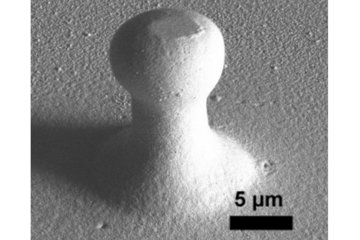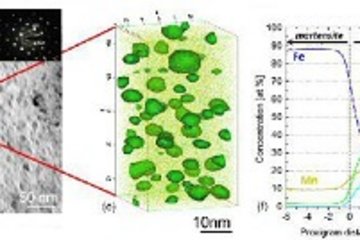All genres
21.
Journal Article
Mechanism for phase transitions and vacancy island formation in alkylthiol/Au(111)self-assembled monolayers based on adatom and vacancy-induced reconstructions. Physical Review B 79 (7), pp. 075440-1 - 075440-6 (2009)
22.
Conference Paper
Oxygen reduction and water at the semiconductor/solution interface probed by stationary and time-resolved ATR-IR spectroscopy coupled to electrochemical experiments and DFT calculations. In: Program of the 8th International Conference on Advanced Vibrational Spectroscopy (ICAVS) – Oral Abstracts, pp. 130 - 131 (Eds. Lendl, B.; Koch, C.; Kraft, M.; Ofner, J.; Ramer, G.). 8th International Conference on Advanced Vibrational Spectroscopy (ICAVS), Vienna, Austria, July 12, 2015 - July 17, 2015. (2015)
23.
Conference Paper
Multiscale simulation of polyurethane network. World Polymer Congress 2012, Blacksburg, Virginia Tech, USA, June 24, 2012 - June 29, 2012. (2012)
24.
Conference Paper
Mesoscale simulation of network formation and structure, combining molecular dynamics and kinetic Monte Carlo approaches. European Polymer Congress 2011, Granada, Spain, June 26, 2011 - July 01, 2011. (2011)
25.
Meeting Abstract
Water adsorption on non polar ZnO surfaces: from single molecules to multilayers. In APS March Meeting 2015, abstract #G8.011. APS March Meeting 2015 , San Antonio, TX, USA, March 02, 2015 - March 06, 2015. (2015)
26.
Meeting Abstract
Water adsorption on non polar ZnO surfaces: from single molecules to multilayers. In DPG Spring Meeting 2015, Abstract: O14.12. DPG Spring Meeting 2015 , Berlin, Germany, March 16, 2015 - March 20, 2015. (2015)
27.
Meeting Abstract
Impact of the vapour pressure of water on the equilibrium shape of ZnO nanoparticles: An ab-initio study. In APS March Meeting 2014, abstract #Q2.009. APS March Meeting 2014 , Denver, CO, USA, March 03, 2014 - March 07, 2014. (2014)
28.
Meeting Abstract
Impact of the vapour pressure of water on the equilibrium shape of ZnO nanoparticles: An ab-initio study. In DPG Spring Meeting 2014, Abstract: O50.6. DPG Spring Meeting 2014 , Dresden, Germany, March 30, 2014 - April 04, 2015. (2014)
29.
Talk
The Mechanism of Electrochemical Oxygen Reduction: A Combined DFT and in-Situ ATR-IR Study on Model Semiconductor Surfaces Ge(100) and ZnO. 227th ECS Meeting, Chicago, IL, USA (2015)
30.
Talk
Catching intermediates of the oxygen reduction reaction in situ: Insights from electrochemical ATIR-IR and DFT. 112th Bunsentagung (Annual German Conference on Physical Chemistry), Karlsruhe Institute of Technology (KIT), Karlsruhe, Germany (2013)
31.
Talk
Towards Understanding the Mechanism of the Electrochemical Oxygen Reduction: DFT Modeling and Spectroelectrochemical Validation. Pacific Rim Meeting on Electrochemical and Solid-State Science PRIME 2012 / ECS 222, Honolulu, HI, USA (2012)
32.
Talk
Electrochemistry of H2O2 on platinum: Towards understadning ORR. Electrochemistry 2012 - Fundamental and Engineering Needs for Sustainable Development (GDCh Meeting), München, Germany (2012)
33.
Talk
Multiscale simulation of polyurethane network. World Polymer Congress 2012, Blacksburg, Virginia Tech, USA (2012)
34.
Talk
Multiscale simulation of PU coatings. BASF-Seminar, Ludwigshafen, Germany (2012)
35.
Talk
Hydrogen peroxide electrochemistry on platinum: Towards understanding the oxygen reduction reaction mechanism. 63rd Annual Meeting of the International Society of Electrochemistry, Prague, Czech Republic (2012)
36.
Talk
In situ Electrochemical ATR-IR Investigation of the Oxygen Reduction on Germanium. 62nd Annual Meeting of the International Society of Electrochemistry, Niigata, Japan (2011)
37.
Talk
Mesoscale simulation of network formation and structure, combining molecular dynamics and kinetic Monte Carlo approaches. European Polymer Congress 2011, Granada, Spain (2011)
38.
Talk
Simulation of polyurethane and water interac-tions with the ZnO surface: DFT and classical OPLS-AA force field calculation. 4-th World Congress on Adhesion and Related Phenomena, Arcachon, France 2010 (2010)
39.
Talk
Ab initio approaches to Solvation Free Energies and Single-Ion Chemical Potentials. Minisymposium "Challenges for Theory in Electrochemistry", MPI für Eisenforschung GmbH, Düsseldorf, Germany (2010)
40.
Talk
The Polymer Day. ICAMS Advanced Discussions, MPIE für Eisenforschung, Düsseldorf, Germany (2010)











